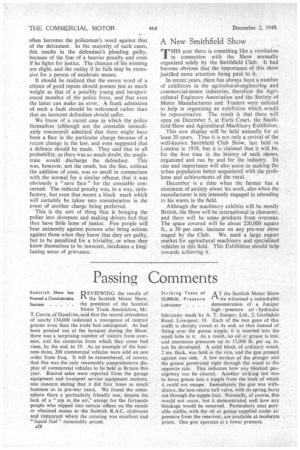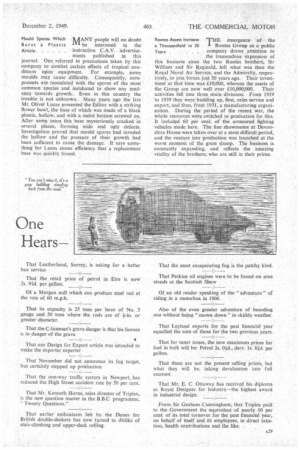Passing Comments
Page 30

Page 31

If you've noticed an error in this article please click here to report it so we can fix it.
Scottish Show has p EVIEWING the results of ,• Proved a Considerable " the Scottish Motor Show,
Success the president of the Scottish
Motor Trade Association, Mr. T. Corrie, of Dumfries, said that the record attendance of nearly 134,000 indicated a resurgence of interest greater even than the tradehad anticipated. As had been pointed out at the banquet during the Show', .there was a surprising number .of visitors from overseas, and the countries from which they came had risen, by the end, to 19. 'Man example of the business done, 200 commercial vehicles were sold on one -order, from Iraq. It will be remembered, of course, that this was the only reasonably .comprehensive display of commercial vehicles to be -held in Britain this year. Record sales were reported from the garage • equipment and transport serviceeqUipment sections, one concern stating that it did four times as much• business as in pre-war years. We found the atmosphere there a particularly friendly' one, despite the . lack of a "nip in the air," except for the fortunate people who nippedinto'certain offices on the stands or obtained access to the Scottish R.A.C. clubroom and restaurant where the catering was excellent and "liquid fuel "-reasonably priced.
A28
Striking Tests of AT, the Scottish Motor Show 15,000-lb. Pressure " we witnessed a remarkable
Lubricator . . . demonstration of a Juniper
high pressure air hydraulic lubricator made by A. T. Juniper, Ltd., 2, Garthdale Road, Liverpool, lg. Each of the two guns of this outfit is sharply coned at its end, so that instead of fitting over the grease nipple, it is inserted into the small hole in it As a result, no oil or grease is lost, and enormous pressures up to 15,000 lb. per sq. in. can be developed. A solid block of ordinary wood, 2 ins thick, was held in the vice, and the gun pressed against -one side. A few strokes of the plunger and the grease penetrated right through the wood to the opposite side. This indicates how any blocked pas'sageway can be cleared, Another striking test was to force grease into a nipple from the back of which it could not escape. Immediately the gun was withdrawn, the non-return ball valve, with its spring, burst out through the nipple face. Normally, of course, this would not occur, but it demonstrated well how any blockage would be removed. Particularly neat portable outfits, with the oil or grease supplied under air pressure from the reservoir, are available at moderate prices. One gun operates at a lower pressure. Mould Spores Which VIANY.peo.ple will no doubt
Burst a Plastic be interested in the
Article instructive C.A.V. advertise ments published in this journal. One referred to precautions taken by this company to combat certain effects of tropical conditions upon equipment. For example, some moulds may cause difficulty. Consequently, components are inoculated with the spores of the most common species and incubated to show any tendency towards growth. Even in this country the trouble is not unknown. Many years ago the late Mr. Oliver Lucas presented the Editor with a striking flower bowl, the base of which was made of a black plastic, hollow, and with a metal bottom screwed on. After some years this base mysteriously cracked in several places, forming wide and ugly defects. Investigation proved that mould spores had invaded the hollow and the pressure of their growth had been sufficient to cause the damage. It says something for Lucas stores efficiency that a replacement base was quickly found. Rootes Assets Increase THE emergence •of the a Thousandfold In' 30 Rootes Group as a public Years . company draws attention to the tremendous expansion of this business since the two Rootes brothers, •Sir William and Sir geginald, left what was then the Royal Naval Air Service, and the Admiralty, respectively, to join forces just 30 years ago. Their investment at that time was £10,000, whereas the assets of the Group are now well over £10,000,000. Their activities fell into three main divisions. From 1919 to 1939 they were building up, first, sales service and export, and then, from 1931, a manufacturing organization. During the period of the recent war, the whole resources were switched to production for this. It included 60 per cent. of the armoured fighting vehicles made here. The fine showrooms at Devonshire House were taken over at a most difficult period, and the venture into production was launched at the worst moment of the great slump. The business is constantly expanding, and reflects the amazing vitality of the brothers, who are still in their prime.












































































































